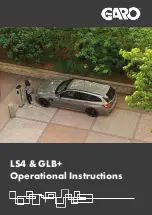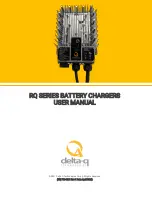
9
E
N
A
p
p
e
n
d
ix
2.3. Other options
The wiring of these signals must be done with the mains disconnected from the charger.
C
ONNECTION BLOCK FOR EXTERNAL SENSORS
,
SWITCH AND RELAY
Figure 5 Connector block
2.3.1. External voltage sensor (see fig 3)
External voltage sensing may be used when accurate battery voltage sensing is important, such as high charging currents in
combination with long cables.
To connect the external voltage sensing option, proceed as follows:
•
connect a red wire (0.75 mm
2
) between the positive battery pole and connector "+ Voltage sensor"
•
connect a black wire (0.75 mm
2
) between the negative battery pole and connector "- Voltage sensor”
•
check that the accompanying LED is lit, otherwise check cabling
2.3.2. External temperature sensor
The external temperature sensor, supplied with the charger, can be connected to these terminals in order to perform
temperature compensated charging of the battery. The sensor is electrically isolated and must be connected to the negative
pole of the battery.
To connect the temperature sensor, proceed as follows:
•
connect the red wire to connector "+ Temperature sensor"
•
connect the black wire to connector "- Temperature sensor"
•
mount the temperature sensor on the negative pole of the battery
•
check that the accompanying LED is lit, otherwise check cabling
2.3.3. Remote on/off
The wiring of the remote switch requires extra attention. Since this input is quite sensitive it is advised to use twisted wires for this
connection.
The remote on/off input can also be connected to an open collector optocoupler: the open circuit voltage is 3 V and the closed
circuit current is 100 µA.
When no remote switch is connected the remote on/off terminals must be short circuited by a short wire.
2.3.4. Alarm relay connections
The alarm relay is triggered by a battery under-voltage situation (<23,8 V). The function may be used for any desirable action:
starting a generator, sounding an alarm etc.
2.3.5. CAN bus connection (VE.Can)
The CAN bus connectors (RJ45) provide access for control (Skylla-i remote control panel or NMEA 2000).
The two RJ45 connecters in each charger (see figure 7) are parallel connected. There is therefore no functional difference
between these connectors.
The end of a CAN cable should have a bus terminator. This is achieved by inserting a bus terminator in one of the two RJ45
connectors and the CAN cable in the other. In case of a node (two CAN cables, one in each RJ45 connector), no termination is
needed.
Several Skylla-i control panels can be connected to one charger or to a set of synchronised and parallel connected chargers.
+
-
Voltage
sensor
+
-
Temperature
sensor
+
-
Remote
on/off
NO NC COM
Alarm relay
Summary of Contents for Skylla-i 24/100 (1+1)
Page 1: ...Manual EN Appendix Skylla i 24 80 1 1 24 80 3 24 100 1 1 24 100 3 ...
Page 2: ......
Page 4: ...4 ...
Page 17: ...1 EN Appendix Appendix A Dimensions ...





































